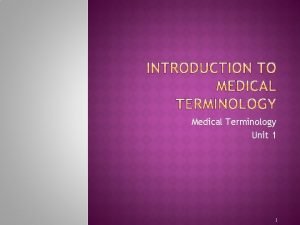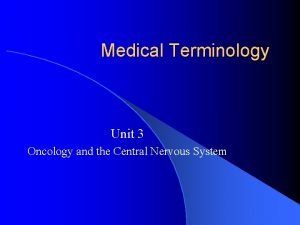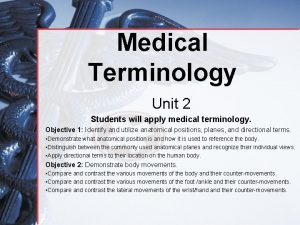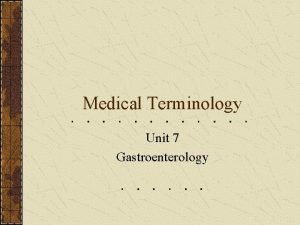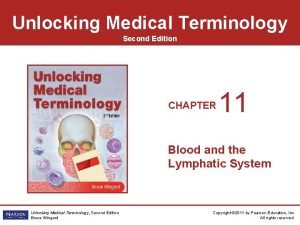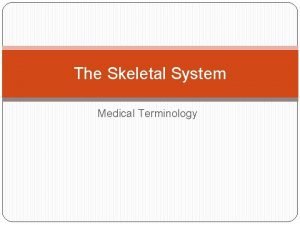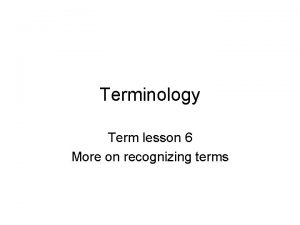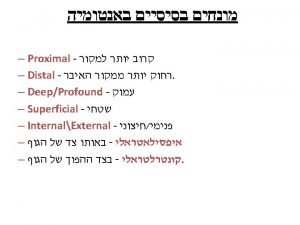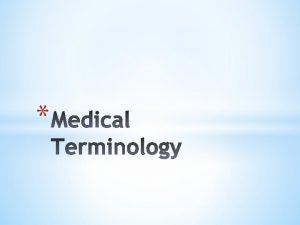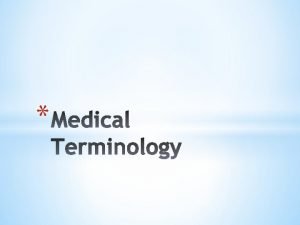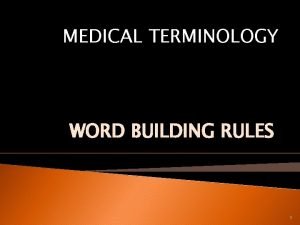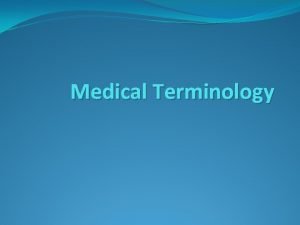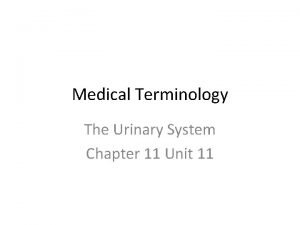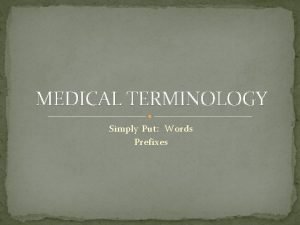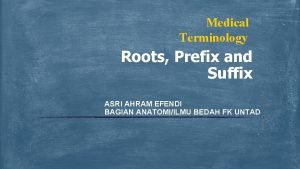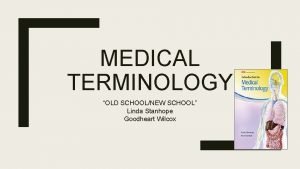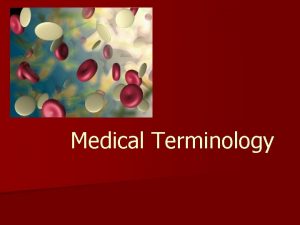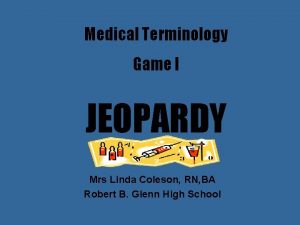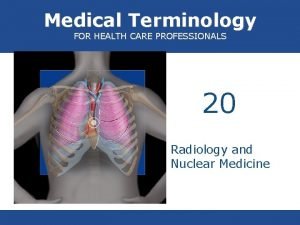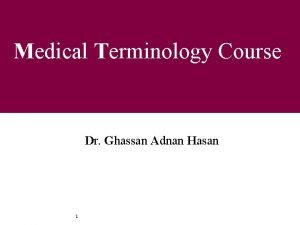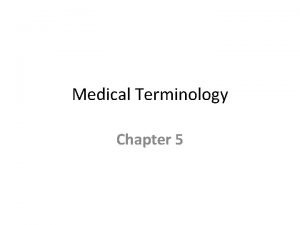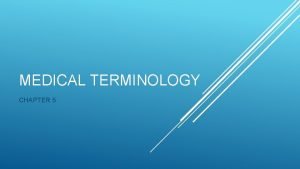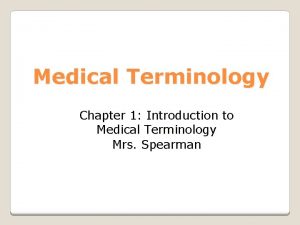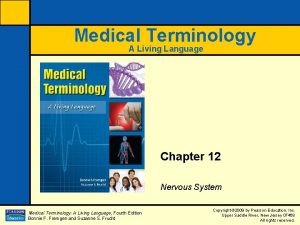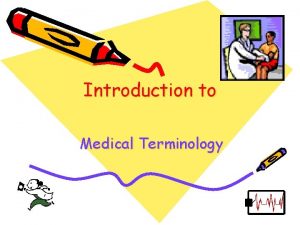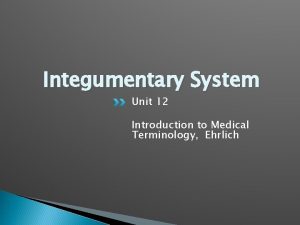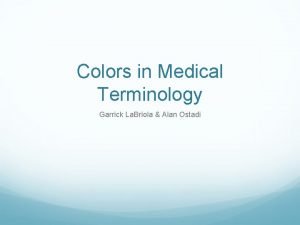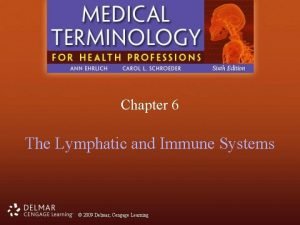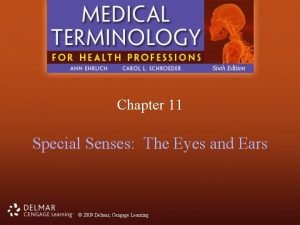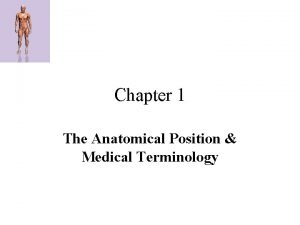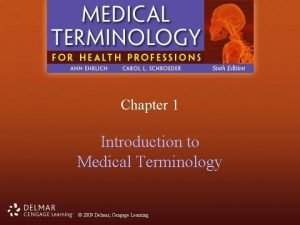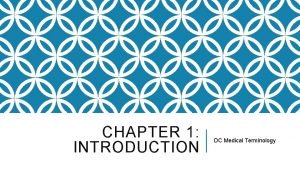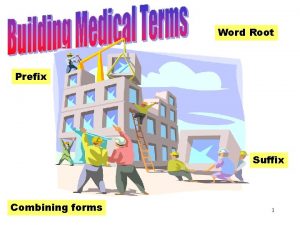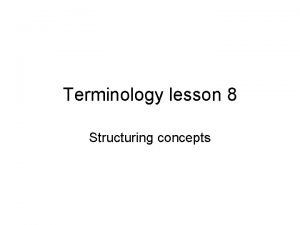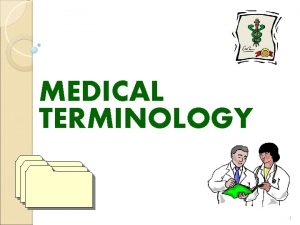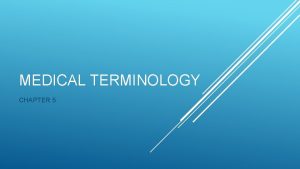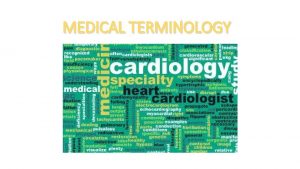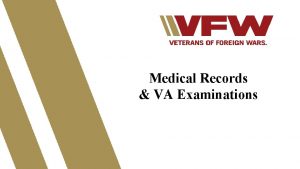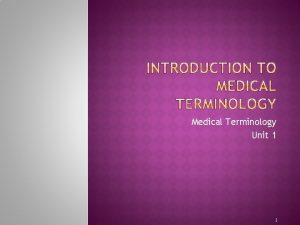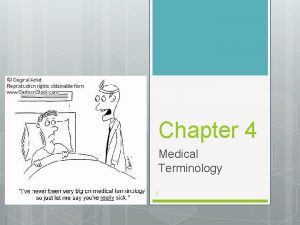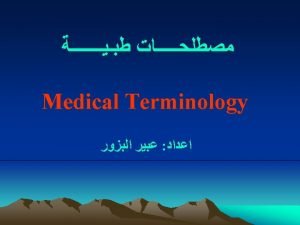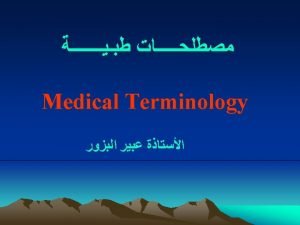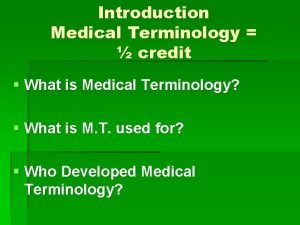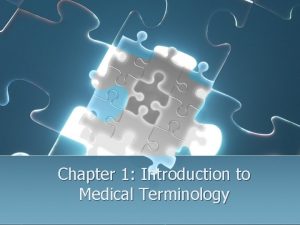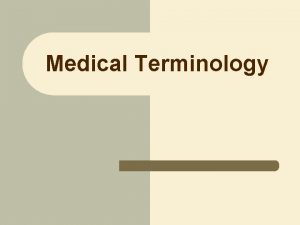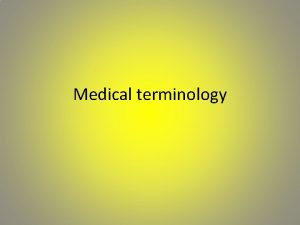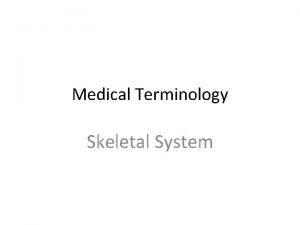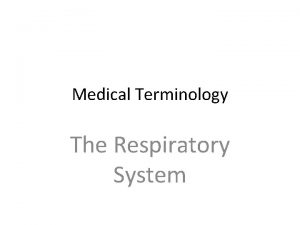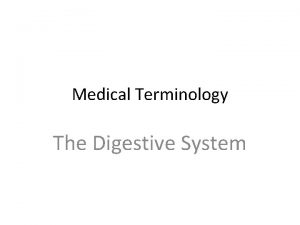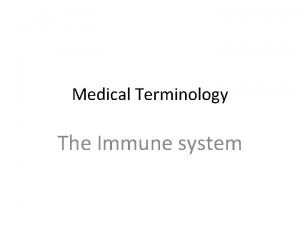Medical Terminology Unit 1 1 Identify the three














































- Slides: 46

Medical Terminology Unit 1 1

Identify the three types of word parts found in medical terms � Define the commonly used prefixes, word roots and suffixes � Discuss the rules for combining medical terms � Recognize the importance of correctly spelling medical terms � Recognize how to change a medical term to its plural form. � Recognize the importance of using correct abbreviations for medical terms � Differentiate between terms and word parts that look -alike or sound-alike � Acquire strategies for using a medical dictionary � Define basic medical terms � 2

� Learning Medical Terminology is easy �Know definitions of word roots (combining forms “/o”) �Know definitions of prefixes �Know definition of suffixes �Understand how to put word parts together �Know how to define medical terms 3

� Word Roots � Suffixes � Prefixes 4

� Also known as combining forms � Foundation of most medical terms � Contain basic meaning of the word � Usually indicate body part involved � Cannot stand alone �Suffix � Some must be added indicate color 5

� Ot/o – Ear � Hepat/o – Liver � Rhin/o – Nose � Oste/o - Bone � Cardi/o – Heart � My/o – Muscle � Neur/o - Nerve 6

� Must be added to all words � Rules for using combining vowels apply � Always added to end of word root � Indicate �Procedure �Condition �Disorder �Disease 7

�A prefix always comes before word Root � Usually indicates �Location �Time �Number �Status � Changes the meaning of the word 8

� Added between root & suffix or between two word roots � Make it easier to say medical term � Most common vowel is “o” � Combining Form Examples �Cardi/o �Leuk/o 9

� Combining Vowel is NOT used when the suffix begins with vowel (a, e, i, o, u) � Root Suffix Neur/o -itis = Neuritis � itis begins with ‘i’ (vowel) � Combining vowel not used – o is dropped 10

� Combining vowel is used when the suffix begins with consonant � Root Neur/o � Combining Suffix -plasty = Neuroplasty Vowel ‘o’ is used 11

� Combining vowel is always used when joining two or more roots Root Suffix gastr/o enter/o -itis = Gastroenteritis � Roots gastr/o & enter/o are added together �Combining vowel ‘o’ used � Root enter/o & suffix -itis �Combining vowel not needed-suffix starts with vowel � 12

� A prefix does not require the use of a combining vowel. � The prefix is added to the front of the first word root Prefix word root suffix pericardi/o -centesis = pericardiocentesis � � No combining form is used after the prefix peri, but is used after the word root cardi/o, because the suffix –centesis starts with a consonant. 13

� Completes term by changing root to an adjective form � ac - al - ary - eal - ical - ial � ic - ine - ior - ory - ous - tic 14

Noun endings � Completes term by changing root to noun form. �a - e - um - us - y – ia – ism 15

� -osis and -esis 16

� Describes specific disease conditions � algia - dynia - itis - malacia � megaly - necrosis - sclerosis 17

� Identify procedure performed on body part � -centesis / -ectomy / -graphy -gram / -plasty / -scopy 18

� -rrhage & -rrhagia �A bursting forth, An abnormal excessive fluid discharge or bleeding Hemorrhage- Loss of large amount of blood in a short time � -rrhea �Abnormal flow or discharge of body fluids Diarrhea-abnormally frequent loose watery stool 19

� -rrhaphy �To suture or stitch Myorrhaphy- To suture a muscle wound � -rrhexis �Rupture Myorrhexis- Rupture of a muscle 20

� � Knowing meaning of WORD Parts helps in figuring out meaning of a term Separate term into word Parts Example: prenatal Prefix Root pre- nat/o before � birth Suffix -al pertaining to Begin your definition with the suffix, follow with the prefix and then the word root. Definition: pertaining to the time before birth 21

otorhinolaryngology Root Suffix ot/o rhin/o laryng/o -ology ear nose throat study of Definition: study of the ears, nose & throat � � tonsillectomy Root Suffix tonsill/o -ectomy tonsil Surgical removal of Definition: surgical removal of tonsils Remember to start you definition first with the suffix, then the prefix (if one) and finally the word root. 22

� Used to assist with term definition � Helps to master correct use of terms � Helps to determine correct meaning of word � Helps to identify correct spelling of term 23

� Write term down � Could be alternate spelling for same sound � Sounds Like May begin with EX F F flatus PH phlegm J G gingivitis J jaundice 24

Sounds Like K May begin with C CH K QU Example crepitus cholera kyphosis quadriplegia 25

Sounds Like S Z May begin with C PS S X Z Example cytology psychologist serology xeroderma zygote 26

Singular ending Plural ending example -a -ae Bursae -ex or –ix -ices Appendix Appendices -is -es Diagnosis Diagnoses -itides Arthritides -nx -nges Phalanx phalanges -on -a Ganglion Ganglia -us -I Alveolus Alveoli 27

� Spell all Medical Terms accurately � Changing just one letter can completely change meaning � Could mean life or death to patient � Example: ileum (part of small intestine) or ilium (part of pelvis) 28

Used as a medical shorthand q Can lead to confusion & errors q Caution when using or translating them q BE Below elbow & Barium enema q Be familiarwith institution guidelines q “When it doubt…write it out. (write out the words if you think there could be any misinterpretation of an abbreviation. q 29

� Sign �Evidence of disease - Fever, Cough Observed by Patient & Other Objective: Evaluated & Measured by others � Symptom �Felt by patient only - Headache / Pain �Subjective: Evaluated by Patient only 30

� Syndrome �Set of Signs & Symptoms �Occur together �Part of a Specific Disease �Examples Fetal Alcohol Syndrome Fatigue Syndrome 31

� Diagnosis �Identification of the disease Congested Heart Failure / Appendicitis Upper Respiratory Disease / Hepatitis B � Differential Diagnosis �Attempt to diagnosis which of several possible diseases all producing same symptoms �Hepatitis A, B, or C � Prognosis �Prediction or Forecast of the probable course or outcome of disease 32

� Acute �Rapid Onset / Severe Course / Short Duration Appendicitis / Upper Respiratory Infection � Chronic �Long duration / Usually controlled Hypertension / Diabetes / Cardiac Disease 33

� Remission �Partial or Complete Disappearance of Symptoms of disease without a cure �Usually Temporary �Leukemia / Cancer 34

� Named for Condition � Chronic Fatigue Syndrome � Fetal Alcohol Syndrome � Eponym (EP-oh-nim) � Named: Person who Discovered-Described it � Ex: Alzheimer’s Disease: Neurologist � Acronym Word formed by using initial letter(s) of compound term � Ex: �LASER Light Amplification by Stimulated Emission of Radiation 35

Confusing Medical Terminology � Arteri/o = Artery � Ather/o = Plaque or Fatty Substance � Arthr/o = Joint � Ileum = Part of Small Intestine � Ilium = Part of the Hip Bone 36

� Infection = Invasion of body by pathogenic organism, local or systemic � Inflammation = Local response to injury or destruction of tissue � Laceration = Torn, Ragged wound � Lesion = Pathological change of tissue due to injury or trauma 37

� Mucous (adj. ) = Specialized membranes that line body cavities � Mucus (n. ) = Substance secreted by the mucous membranes � Myc/o = Fungus � Myel/o = Bone Marrow or Spinal Cord � My/o = Muscle 38

� -ologist = Specialist �Radiologist-MD reads X-Rays �Cardiologist- MD treats conditions of heart � -ology = Study of �Radiology – Study of X-Ray therapy �Cardiology – Study of the Heart conditions �Neonatology – Study of newborn conditions 39

� -ostomy = Creation of artificial opening �Tracheostomy – Creating opening in Trachea �Colostomy – Creating an opening in Colon � -otomy = Surgical Incision �Thoracotomy – Incision in Chest cavity �Colotomy - Incision into Colon ***these two word parts are VERY commonly confused. Take extra time to memorize these 40

� Palpation- to examine the patient with one’s hands � Palpitation- a pounding or racing heart 41

� Prostate = Male Gland under the urinary bladder � Prostrate = To collapse or lying Flat � Supination = Rotation of arm with palm of hand forward � Suppuration = Formation or discharge of pus 42

� Suturing = Act of closing a wound or incision by stitching � Ligation = Act of binding or tying off blood vessels or ducts � Triage = Medical Screening of patients to determine priority of need � Trauma = Wound or Injury 43

� Viral = Pertaining to a virus � Virile = Possessing masculine traits 44

� Hypotension: low blood pressure � Hypertension: high blood pressure � Addiction: a strong dependence on a drug or substance. � Edema: Excessive build-up of fluid � Intramuscular: within the muscle � Phalanx: Finger or toe (plural phalanges) � Gerontology: study of aging (old age) � Gerontologist: specialist in the treatment of aging individuals. 45

The End There is no substitute for daily preparation! Review your flashcards every day. 46
 Palpitation
Palpitation Otorhinolaryngology medical terminology
Otorhinolaryngology medical terminology Medical terminology unit 3
Medical terminology unit 3 Medical terminology unit 2
Medical terminology unit 2 Proct o medical term
Proct o medical term The purpose of traffic signs are
The purpose of traffic signs are Chapter 11 medical terminology
Chapter 11 medical terminology Medical terminology skeletal system
Medical terminology skeletal system Anterior posterior lateral
Anterior posterior lateral Lesson 6 medical terminology
Lesson 6 medical terminology Medical terminology lesson 12
Medical terminology lesson 12 Pleur prefix
Pleur prefix Erythrocytopenia root word
Erythrocytopenia root word Dextro prefix
Dextro prefix Khan cademy
Khan cademy Word building rules in medical terminology
Word building rules in medical terminology Medical terminology
Medical terminology Ophthalm medical terminology
Ophthalm medical terminology Urethr/o medical term
Urethr/o medical term Hepa prefix
Hepa prefix Root word medical terminology examples
Root word medical terminology examples Stanhope chapter 13 quizlet
Stanhope chapter 13 quizlet Basic medical terms
Basic medical terms Tel/o medical term
Tel/o medical term Are medical terms universal
Are medical terms universal Red medical terminology
Red medical terminology Jeopardy medical terminology
Jeopardy medical terminology Medical terminology for radiology
Medical terminology for radiology Accented syllable in cephalic
Accented syllable in cephalic Throat medical terminology
Throat medical terminology Perineuritis medical terminology
Perineuritis medical terminology Appendectomy word breakdown
Appendectomy word breakdown Medical term for standing up
Medical term for standing up Chapter 12 medical terminology
Chapter 12 medical terminology Medical positions of the body
Medical positions of the body Medical terminology symbols
Medical terminology symbols Integumentary
Integumentary Albus color
Albus color Chapter 6 learning exercises medical terminology
Chapter 6 learning exercises medical terminology Medical terminology chapter 11 learning exercises answers
Medical terminology chapter 11 learning exercises answers Anatomical position medical term
Anatomical position medical term Chapter 1 matching medical terminology
Chapter 1 matching medical terminology Oste medical term
Oste medical term Emesis suffix
Emesis suffix Medical terminology lesson 4
Medical terminology lesson 4 Medical terminology lesson 8
Medical terminology lesson 8 Phren o medical term
Phren o medical term
